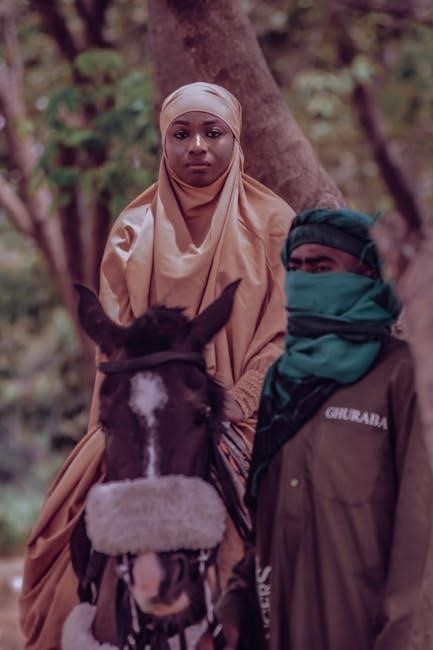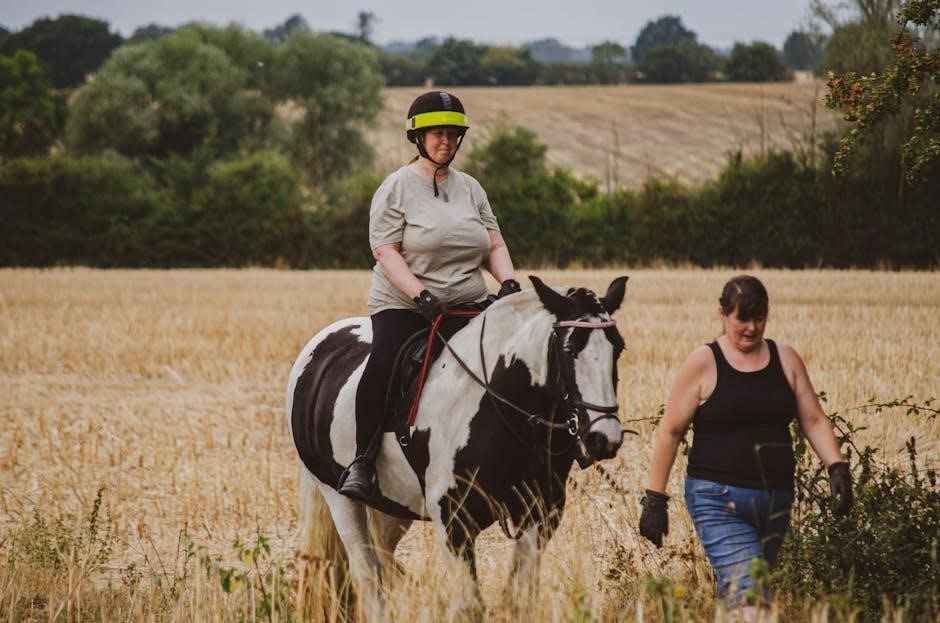
Understanding when and how to blanket your horse is crucial for maintaining their comfort and health. This guide provides essential insights into temperature ranges, factors influencing blanketing needs, and selecting the right blanket for optimal warmth and protection, ensuring your horse stays comfortable in varying conditions.
Understanding the Importance of Horse Blanketing
Horse blanketing is essential for maintaining your horse’s comfort and health, especially in cold or wet conditions. Horses naturally regulate their body temperature, but extreme weather can challenge this ability. Blankets provide insulation, protecting against cold, wind, and rain, which can lower a horse’s body temperature. Clipped or senior horses may need extra protection, as they lose natural insulation. Wet conditions are particularly dangerous, as soaked coats lose insulating properties. Blankets help prevent hypothermia and ensure your horse stays warm and dry, making them a critical part of equine care during colder months.
Objective of the Guide
This guide aims to provide comprehensive insights into horse blanketing, focusing on temperature guidelines, factors influencing blanketing needs, and selecting the right blanket. It offers practical advice on when to blanket, how to choose the appropriate blanket type, and how to maintain it. The guide also addresses special considerations for clipped, senior, and horses with health issues, ensuring you can make informed decisions tailored to your horse’s specific needs. By following this guide, you can ensure your horse remains comfortable and protected in various weather conditions throughout the year.

Factors Influencing Blanketing Needs
Horse age, health, hair coat, climate, and living conditions significantly impact blanketing needs. Wet weather and wind chill can lower body temperature, making blanketing essential for comfort and protection.
Horse Age and Health Status
Horse age and health significantly influence blanketing needs. Senior horses often require more care, as they may have reduced tolerance for cold and potential health issues like Cushing’s disease. Younger horses, especially foals, may need extra protection in harsh weather. Horses with health conditions, such as respiratory issues or limited mobility, may benefit from additional warmth. Monitoring their comfort and adjusting blankets accordingly ensures their well-being. Proper blanketing helps maintain their body temperature and overall health, especially during colder months or wet conditions.
Hair Coat and Clipping
A horse’s hair coat and clipping status play a significant role in determining blanketing needs. A natural hair coat provides insulation, but clipped horses lose this layer, requiring additional warmth. Horses with a full coat can tolerate colder temperatures without heavy blanketing, while clipped horses may need lighter blankets even in milder conditions; The length and thickness of the coat, along with the extent of clipping, influence the type and weight of the blanket. Monitoring a horse’s comfort and adjusting blankets based on their coat and environment ensures optimal warmth and prevents overheating;
Climate and Geographic Location
Climate and geographic location significantly influence a horse’s blanketing needs. Horses in colder climates may require heavier blankets to withstand freezing temperatures and wind chill, while those in milder regions need lighter options. Humid or wet conditions necessitate waterproof blankets to prevent chilling. Regional temperature variations, such as frequent freezes or cool nights, also dictate blanket weight and type. Horses in coastal areas may need more breathable fabrics due to moisture, whereas those in dry, cold regions benefit from insulated options. Understanding local weather patterns helps tailor blanketing strategies for optimal comfort and protection.
Outdoor vs. Stabled Horses
Horses kept outdoors often require more robust blanketing due to exposure to wind, rain, and colder temperatures. Outdoor horses benefit from waterproof and breathable blankets to stay dry and warm, especially in wet conditions. Stabled horses, however, may need lighter blankets since they are sheltered from harsh weather. The type of shelter available to outdoor horses, such as access to a barn, can also influence blanketing needs. Proper blanketing helps ensure comfort and prevents heat loss, whether your horse is stabled or spending time outdoors.

Types of Horse Blankets
Horse blankets vary in weight, material, and design to suit different needs. Lightweight, medium-weight, and heavyweight options offer tailored warmth for specific temperature ranges and conditions.
Lightweight Blankets
Lightweight horse blankets are designed for mild weather conditions and provide minimal insulation. They are ideal for temperatures between 40°F and 60°F for clipped horses or 30°F to 50°F for those with natural coats. These blankets typically have a fill power of 80-120 grams, making them suitable for spring, fall, or early winter. They are perfect for horses that do not need heavy insulation but still require protection from wind, rain, or chilly mornings. Lightweight options often feature breathable fabrics like nylon or polyester, ensuring comfort and moisture-wicking properties. They are a great choice for horses that are sensitive to heat or live in regions with milder winters.
Medium-Weight Blankets
Medium-weight horse blankets are designed for colder temperatures, typically between 25°F and 45°F, providing balanced insulation without being overly heavy. These blankets usually have a fill power of 150-250 grams, making them suitable for horses with moderate coats or those exposed to harsher weather conditions. They are ideal for clipped horses in colder climates or for horses that need extra warmth during consistent cold snaps. Medium-weight blankets often feature durable materials like polyester or rip-stop nylon to withstand rough use. They are a versatile option for transitioning seasons or regions with fluctuating temperatures, ensuring your horse stays comfortable and protected.
Heavyweight Blankets
Heavyweight horse blankets are designed for extreme cold, typically used in temperatures below 25°F. These blankets have a high fill power of 300-400 grams, providing maximum insulation for horses exposed to harsh winter conditions. They are ideal for senior horses, clipped horses, or those with health issues that impair their ability to retain heat. Made from durable materials like 1680D or 2400D nylon, these blankets are built to withstand rough weather and prolonged use. Features such as adjustable necks and gusseted shoulders ensure a secure fit, while waterproof coatings protect against snow and ice. Heavyweight blankets are essential for keeping vulnerable horses warm and comfortable in freezing temperatures.
Waterproof Blankets
Waterproof horse blankets are essential for protecting horses from cold, wet conditions. Designed to repel rain and snow, these blankets prevent the horse’s coat from becoming soaked, which can lead to heat loss. Typically made from durable materials like 1680D or 2400D nylon, they feature waterproof coatings to ensure dryness. Waterproof blankets are ideal for use in rainy or snowy climates and are often paired with insulating layers for added warmth. They are particularly beneficial for horses exposed to harsh weather, ensuring they remain dry and comfortable in freezing temperatures.
Combination Blankets
Combination blankets are versatile options that offer both insulation and waterproofing, making them ideal for unpredictable weather conditions. These blankets often feature adjustable neck covers and multi-layered insulation, providing warmth in cold temperatures while protecting against rain and wind. Designed for horses that need consistent protection, combination blankets are perfect for outdoor use in climates with frequent precipitation. They are especially beneficial for horses that spend extended periods in pastures or paddocks, ensuring they stay dry and warm without compromising comfort. Their adaptability makes them a practical choice for varying weather scenarios.

Temperature Guidelines for Blanketing
Understanding temperature guidelines for blanketing is crucial. Generally, horses need blankets below 40°F to 50°F, depending on coat type and weather conditions like wind and rain.
General Temperature Ranges
Blanketing decisions should align with temperature ranges. Typically, horses need blankets when temperatures drop below 40°F to 50°F, depending on their coat and health. For unclipped horses, blanketing is usually necessary below 40°F, while clipped horses may need it below 50°F. Senior or sick horses often require blanketing at higher temperatures, around 55°F. Consider wind chill and humidity, as these can lower the effective temperature. Always monitor your horse’s comfort and adjust blanketing based on individual needs and weather conditions. Checking daily can ensure your horse stays warm and comfortable without overheating.
Regional Variations in Temperature
Geographic location significantly influences horse blanketing needs. In colder northern climates, horses may require heavier blankets at higher temperatures due to prolonged cold exposure. Conversely, in southern regions with milder winters, lighter blankets or delayed blanketing may suffice. Coastal areas with consistent temperatures often require moderate blanketing, while inland regions with extreme temperature swings demand closer monitoring. Understanding local climate patterns is essential to ensure horses remain comfortable without overloading them. Always consider regional weather trends when deciding blanket weight and timing for optimal comfort and health. Adjustments may be needed based on specific local conditions.
Wind Chill and Precipitation Factors
Wind chill and precipitation significantly impact a horse’s ability to stay warm. Cold, wet, and windy conditions can rapidly lower a horse’s body temperature, increasing the need for adequate blanketing. Rain or snow can soak a horse’s coat, reducing its insulating properties and making it harder for the horse to retain heat. Waterproof blankets are essential in such conditions to keep the horse dry and warm. Additionally, wind chill can make the air feel much colder than the actual temperature, further stressing the horse. Always consider these factors when deciding the weight and type of blanket to use, ensuring your horse remains comfortable and protected.
How to Choose the Right Blanket
Selecting the right blanket involves considering insulation levels, waterproofing, breathability, and proper fit. Assess your horse’s specific needs to ensure optimal comfort and protection in varying conditions.
Insulation Levels and Fill Power
Insulation levels and fill power determine a blanket’s warmth. Lightweight blankets (80-120g fill) suit temperatures between 40°F-60°F for clipped horses and 30°F-50°F for those with natural coats. Medium-weight (120-200g) is ideal for 30°F-50°F (clipped) or 20°F-40°F (natural). Heavyweight (200-350g) is best for extreme cold, below 30°F (clipped) or 20°F (natural). Higher fill power offers greater warmth, but breathability is key to prevent overheating. Always consider your horse’s specific needs, such as age, health, and activity level, to choose the right insulation level and ensure comfort.
Fabric Types and Breathability
Fabric types play a crucial role in maintaining your horse’s comfort. Waterproof blankets, often made from durable polyester, protect against rain and wind, while breathable fabrics like cotton or mesh allow moisture to escape, preventing overheating. Turnout blankets with rip-stop nylon are ideal for outdoor use, offering both durability and weather resistance. High-denier fabrics (e.g., 1200D) are more abrasion-resistant, suitable for active horses. Breathability ensures your horse stays dry and comfortable, preventing skin irritation. Always balance waterproofing with breathability to avoid trapping heat and moisture, ensuring optimal comfort in varying weather conditions.
Proper Fit and Sizing
Ensuring a proper fit is essential for your horse’s comfort and safety. A well-fitted blanket prevents rubbing and chafing, while allowing freedom of movement. Measure your horse accurately, considering length, chest width, and neckline. A correct fit should cover from the poll to the tail, with adjustable surcingles and leg straps for security. Avoid oversizing, as it may shift or cause discomfort. Regularly check the fit, especially for growing or changing horses, to ensure optimal comfort and protection against cold and wind, promoting overall well-being and preventing potential health issues associated with poor blanket fit.
Adjusting Based on Individual Needs
Each horse has unique requirements, so tailoring your blanketing strategy is key. Monitor temperature, humidity, and wind chill to determine the right blanket weight. Clipped horses or those with health issues may need extra warmth, while heavier-coated horses might require less. Senior horses often benefit from additional insulation due to reduced natural insulation. Young horses may need lighter options to prevent overheating. Adjustments should also consider activity levels and shelter availability, ensuring the blanket adapts to changing conditions and individual comfort, preventing both overcooling and overheating for optimal health and well-being.

Maintenance and Care of Horse Blankets
Regular cleaning, proper storage, and timely repairs are essential to prolong blanket life. Wash with mild detergents, store in dry areas, and inspect for wear to ensure durability and effectiveness.
Cleaning and Washing
Proper cleaning and washing of horse blankets are vital for maintaining hygiene and functionality. Use mild detergents to avoid damaging materials, and avoid harsh chemicals that may degrade waterproof coatings. For heavily soiled areas, spot clean with a soft brush and gentle soap before machine washing. Ensure blankets are thoroughly rinsed to remove all detergent residue, as leftover soap can irritate your horse’s skin. Allow blankets to air dry completely, avoiding direct sunlight which can cause fading or weakening of fabrics. Regular cleaning prevents odor buildup and ensures optimal performance during cold weather. This routine also extends the lifespan of the blanket, making it a cost-effective practice for horse owners. By following these steps, you can keep your horse’s blankets in excellent condition, providing comfort and protection throughout the seasons.
Storage and Organization
Proper storage and organization of horse blankets are essential to maintain their quality and extend their lifespan. Store blankets in a clean, dry, and well-ventilated area to prevent mold and mildew. Use breathable storage bags or containers to protect them from dust and pests. Organize blankets by weight and type for easy access during changing seasons. Label each blanket to quickly identify its thickness and purpose. Avoid folding blankets when possible, as creases can weaken the fabric over time. Instead, roll them neatly to maintain their shape and integrity. This method ensures your horse’s blankets remain in optimal condition and are ready for use when needed.
Repair and Maintenance Tips
Regular maintenance and timely repairs are vital to extend the life of horse blankets. Inspect blankets seasonally for tears, worn areas, or broken buckles. Use durable fabric repair kits to patch small holes, and replace damaged hardware promptly. Clean blankets before storing to prevent mold and mildew. Avoid using harsh detergents that can degrade waterproof coatings. For heavy-duty repairs, consider professional services. Routine care ensures blankets remain functional, providing consistent warmth and protection for your horse. By addressing issues early, you can prevent minor problems from becoming costly or rendering the blanket unusable.

Special Considerations
Special considerations include blanketing senior horses, clipped horses, and those with health issues, ensuring their needs are met based on age, health, and specific blanketing requirements.
Blanketing Senior Horses
Senior horses often require extra attention when it comes to blanketing due to potential weight loss, thinner coats, and less efficient thermoregulation. They may need blanketing at higher temperatures than younger, healthier horses. Monitor their condition closely, as some seniors may need lightweight blankets even in moderate cold. Consider their ability to maintain body heat and adjust blanket weight and fit accordingly. Proper blanketing helps ensure their comfort and health during colder months.
Blanketing Clipped Horses
Clipped horses require extra attention as their natural insulation is reduced. They typically need blanketing at higher temperatures than unclipped horses, often starting around 60°F. Monitor their comfort closely, as their ability to retain heat is compromised. Lightweight or medium-weight blankets are usually sufficient, but adjust based on weather conditions. Ensure proper fit to avoid rubbing and discomfort. Regularly check for signs of overheating or chilling, as clipped horses may need more frequent blanket changes. Their specific needs make them a priority when deciding on blanketing strategies.
Horses with Health Issues
Horses with health issues often require special blanketing considerations. Those with conditions like arthritis or circulatory problems may need extra warmth to stay comfortable. Blanketing at higher temperatures, even above 50°F, can be necessary to prevent discomfort. Monitor their condition closely, as some health issues may affect their ability to regulate body heat. Adjust blanket weight and type based on individual needs, and consult a veterinarian for specific guidance. Proper blanketing can significantly improve their quality of life and prevent complications related to cold stress.
Proper horse blanketing is essential for their comfort and health. Monitor temperature, health, and individual needs, adjusting blankets accordingly to ensure optimal warmth and protection.
Understanding temperature guidelines and individual horse needs is crucial for effective blanketing. Factors like age, health, and living conditions influence blanketing decisions. Lightweight blankets are ideal for milder temperatures, while heavyweight options are best for extreme cold. Waterproof blankets protect against rain and wind, ensuring insulation remains effective. Proper fit, breathability, and regular maintenance are essential for comfort and durability. Always consider regional variations in temperature and adjust based on your horse’s specific requirements to ensure optimal comfort and health.
Final Tips for Effective Blanketing
Always monitor your horse’s comfort and adjust blankets according to weather changes. Ensure a proper fit to prevent rubbing and discomfort. Regularly inspect and maintain blankets to uphold their quality and functionality. Consider your horse’s individual needs, such as age, health, and coat condition, when selecting blankets. Store blankets clean and dry during off-seasons to preserve their insulation properties. By following these tips, you can effectively protect your horse from harsh conditions while promoting their overall well-being and comfort throughout the year.